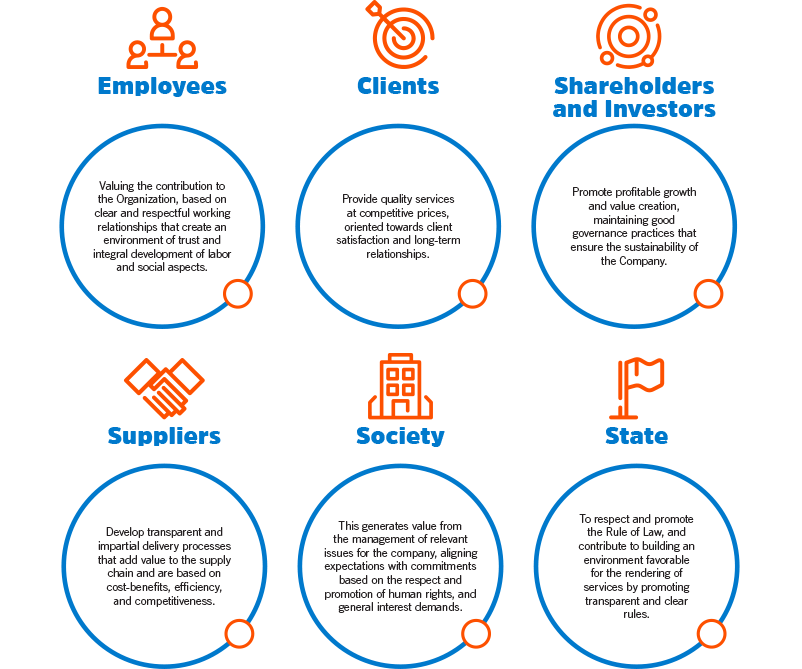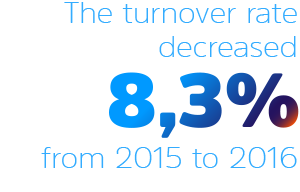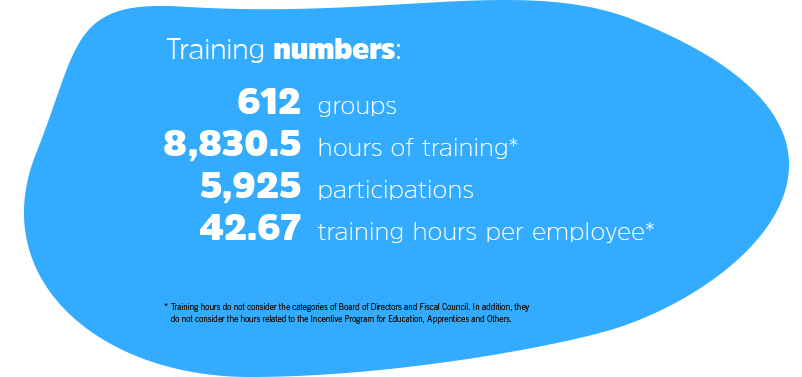G4-26
In its operating strategy, ISA CTEEP analyzes the social, environmental and economic impacts that its activities can bring, seeking to balance the growing needs of its business and the demands of society.
The Company considers the public for engagement its employees, clients, shareholders and investors, suppliers, state society. The definition of these stakeholders is based on the direct or indirect involvement, maintained with each audience, which might be impacted by its activities or have a relevant impact on the business. This concept is also covered in the Corporate Guidelines for Business Sustainability Management, published by ISA and applicable to ISA CTEEP and its subsidiaries. G4-24, G4-25

RELATIONSHIP CHANNELS
G4-26In order to maintain a frequent and active relationship with its various stakeholders, ISA CTEEP promotes a series of actions ranging from the publication of the Annual and Sustainability Report to participation at events, forums and sector meetings. The Company also has various communication and relationship channels, which consolidate the ongoing dialogue with these groups, for example:
- Primeira Linha Magazine
-
- A digital communication channel featuring news and corporate information directed at employees, with 980 users: 72% of employees who are active on our network, on average, access the magazine.
- Transnet
-
- During the year, the Company’s new intranet was launched, which underwent a redesign process, with improvements focused on content and navigation, and to adopt a more modern technological platform. 828 users on average access Transnet, representing 56% of employees.
- Corporate website and investor relations website
-
- In 2016, both the institutional site – featuring news and corporate information geared toward at stakeholders – and the investor relations site – aimed at investors, shareholders and the market – also went through an overhaul process, now offering a more modern and user-friendly interface, including a number of features that are better distributed on the platform, as well as being responsive to smartphones and tablets.
- Contact us
-
- Channel to solve concerns, requests and complaints of the society in general. Further information in the chapter “Company”.
- “Circuito ISA CTEEP”
-
- Main face to face communication channel between the Company’s top management and the employees, “Circuito ISA CTEEP” was reformulated, with the implementation of a new collaborative model, allowing the generation of reflection and encourage collective construction. During the year, two editions of the meeting were held, and 1,250 employees attended, ensuring a greater participation of the teams in discussion and suggestions of solutions on themes proposed: compliance with the procedures and security. As result of the implementation of this new model, the satisfaction rate recorded by the participants in the year was 99%, an increase of 18.5 points compared to the prior year.
- Conference call with the market
-
- ISA CTEEP makes a conference call on a quarterly basis to present its results for the period and maintain relationship with shareholders and investors.
REPUTATION SURVEY
G4-26For the second consecutive year, ISA CTEEP applied the Corporate Survey on Reputation, using the RepTrack methodology from Reputation Institute, in order to identify the perception of its stakeholders about the management of reputation and the perception that they have of the Company.
The survey was applied to stakeholders, Employees and Shareholders, on quantitative basis, and Clients, State, Academy and Trade Associations under the qualitative methodology. An improvement was identified in every group regarding the same survey applied in 2013.
INSTITUTIONAL COMMITMENTS TO SUSTAINABLE DEVELOPMENT
G4-15Important sustainability management references guide ISA CTEEP activities by means of instruments used by the parent company. One of them is the Global Pact, to which the Company is signatory since 2011, committed to and presenting annual advances in relation to ten principles of Human Rights, Labor Rights, Environmental Protection and Anti-corruption.
Another important guiding element is Dow Jones Sustainability Index (DJSI). ISA CTEEP activities, and consequently of its subsidiaries, were important to ISA’s inclusion in the index in 2015 and continuity in 2016. Every year, ISA CTEEP adopts a self-diagnosis based on DJSI, aiming at the determining Company’s development stage referring to sustainability topics, identifying gaps, and implementing management improvements through a structured action plan covering different Company’s departments. The improvement plan for 2016 was fully complied with and involved initiatives related to the themes: human rights, management of suppliers and social and environmental management.
ISA CTEEP also follows the requirements of standard ABNT NBR ISO 14001, since there is an Environmental Management System (SGA) since 2012 and that it incorporates, since then, a series of improvements in processes that cover the wholly-owned subsidiaries, such as monitoring of the environmental legislation; standardization of monitoring and environmental controls; and the adoption of measures for reduction of environmental impacts.

Prepare the employees and the Company for the new cycle of business growth. After this positioning, ISA CTEEP adopted, in 2016, a new focus to the personnel management process, with the materialization of more strategic actions directed to Company’s future needs.
In addition to investing in the training of the teams, HR activities are now more systemic, promoting the creation of a work environment that allows the individual and collective development along with the business demands.
As result of the review of this model, all the backoffice and operation areas began to have a BP Advisor (Business Partner), a professional who works as HR business partner and the mission is to promote the approximation with other areas and work as a facilitator for the themes related to personnel management.
This movement was fundamental to ensure joint operation and the evolution conquered in the year, reinforcing the importance of the employees in the attainment of the results.
EMPLOYEE PROFILE
In 2016, the number of ISA CTEEP’s employees remained virtually unchanged, with the addition of only 12 employees in relation to 2015, totaling 1,481 people.
The percentage of women had a small increase, from 11.00% to 12.22%. The balance of gender is higher among leaders, administrative professionals, interns and apprentices, and lower between operating technicians. The Company has no goals related to the theme.
In relation to age bracket, 55.00% of the staff is formed by people between 30 and 50 years old. In addition, the Company has more employees above 50 years-old (24.00%) than under 30 (21.00%). The younger ones are concentrated in the Administrative category, as well as interns and apprentices.
- EMPLOYEES BY GENDER, AGE AND EMPLOYMENT CATEGORY G4-10, G4-LA12
-
-
Ownemployees
by Functional CategorySubtotal By gender By age Female Men < 30 30 - 50 > 50 Board Members 20 3 17 0 1 19 President 1 0 1 0 0 1 Directors 4 0 4 0 1 3 Managers 24 5 19 0 11 13 Coordinators and Experts 85 16 69 0 46 39 Clerks 238 116 122 60 140 38 Operating technicians 1,038 14 1,024 182 613 243 Interns 64 22 42 64 0 0 Learners 7 5 2 7 0 0 Total 1,481 181 (12.22%) 1.300 (87.78%) 313 (21.00%) 812 (55.00%) 356 (24.00%) Note: The experts were allocated to the Administrative category and, as of 2016, they were added to the Coordinators.
-
Of the total employees, 62 are disabled people, of which 57 from the Administrative area and five from the Operating area. ISA CTEEP does not monitor on regular and structured basis other diversity indicators, such as race and ethnicity, nor the number and profile of outside employees of its suppliers.
In 2017, the control over this information should be improved, since the Company believes that this kind of information help to understand the diversity of the employees’ profiles, enriching the work environment. To know the data on the employees’ diversity allows to identify elements to plan on a more assertive manner the communications, trainings, hires and other human management initiatives.
At ISA CTEEP, the work relations between any group, irrespective of their characteristics, follow ethical assumptions and are based on mutual respect, which are addressed in instruments such as the Human Management Policy, Code of Ethics and Declaration of Human Rights.
HIRES AND TURNOVER
G4-LA1
 The turnover rate decreased, from 7.68% in 2015 to 7.04% in 2016. The result, which shows the continuity of the human capital valuation, derives from the increase in the number of hires and from the reduction of layoffs in the period.
The turnover rate decreased, from 7.68% in 2015 to 7.04% in 2016. The result, which shows the continuity of the human capital valuation, derives from the increase in the number of hires and from the reduction of layoffs in the period.
The turnover rate (or turnover) is calculated as follows: the sum of hires and layoffs is divided by two, then divided by the total number of employees (except for Directors, President, Officers, Interns and Apprentices). The calculation considers the layoffs made by initiative of the employee and by the Company, death, just cause and bilateral agreements. To identify the reasons of turnover, ISA CTEEP conducts exit interview and climate survey as the principal instruments, which helps to identify opportunities of management improvement.
- HIRES AND TURNOVER
-
-
Categories 2015 2016 Total number of new hirings 104 107 New hires by gender - men 82 80 New hires by gender - women 22 27 New hires by age bracket - under 30 years 48 65 New hires by age bracket - from 30 to 50 years 55 38 New hires by age bracket - above 50 years 1 4 Total layoffs 106 88 Layoffs by gender - men 97 72 Layoffs by gender - women 9 16 Layoffs by age bracket - under 30 years 6 9 Layoffs by age bracket - from 30 to 50 years 60 45 Layoffs by age bracket - above 50 years 40 34 Turnover rate - Global (%) 7.68 7.04 Turnover rate by gender - men 7.29 6.16 Turnover rate by gender - women 11.07 14.24 Turnover rate by age bracket - under 30 years 12.80 15.29 Turnover rate by age bracket - from 30 to 50 years 6.38 5.12 Turnover rate by age bracket - above 50 years 8.01 5.71 Note: The experts were allocated to the Administrative category and, as of 2016, they were added to the Coordinators.
-
RETIREMENT
G4-EU15The Company estimates that in the next five years, 202 employees will retire because they will reach the age or period of contribution established in the Pension Plan, that is, 14% of its current staff. Of this group, four (2%) are executive positions, 61 are graduate level (30%), 109 of technical level (54%) and 28 of operating level (14%). The percentages refer to the universe of employees about to retire and not to the total staff.
Considering the next ten years, this number raises to 320 employees about to retire, being six executives, 84 of graduate level, 197 of technical level and 39 of operating level. The number of professionals about to retire in up to five years represents 14% of all the employees of the Company.
The scenario reinforces the importance to strengthen knowledge transfer processes and assistance in the transition of these employees to the retirement phase, so that the most experienced professional are able to maintain their legacy to the future generations and, at the same time, prepare to the new phase of life. Although the interchange of knowledge is informally made through projects, there is not a structured program for the preparation of professionals for the retirement. G4-LA10
TRAINING AND DEVELOPMENT
G4-LA9, G4-EU14In order to prepare the employees for the challenges of the power transmission sector, ISA CTEEP promotes trainings and events, including professional formation, capability and qualification of its staff.
During the year, the amount of R$ 3.1 million was invested in technical and administrative courses, including the Education Incentive Program. The amount is equal to the value allocated in 2015.

Courses and trainings include on-site, on-line (distance) and on the job types. For all types of training, internal and external events such as courses, seminars, workshops, symposiums, conferences, lectures, forums, congresses and other related events of significance and priority for the Company are considered.
One of the highlights of 2016 was the repositioning of the program of development and leadership, with the implementation of the first module of the ELO Program (Evolve, Lead, Obtain), whose main purposes are as follows:
- to accelerate the development of ISA CTEEP Leaders, so they continue to create an environment of sustainable business growth.
- to expand the leaders’ awareness in relation to their role and their impact on the development of their teams.
- to raise the level of trust and the team spirit between the leaders.
- to strengthen the business acumen and integrated performance.
With the implementation of the first module ("Me") in November 2016, of on-site capability program to directors and managers, the other two modules ("Me and the team" and "Me and the organization") will be promoted in 2017, with the participation up to the level of Coordinators.
- TRAININGS BY FUNCTIONAL CATEGORY AND GENRE (TOTAL AND AVERAGE HOURS)
-
-
Functional category Hours of training offered Average training hours per employee Men Female Men Female Directors 12.0 0.0 0,001 0 Managers 294.0 8.0 0,200 0,005 Coordinators 2,436.5 119.5 1,670 0,082 Clerks 2,353.0 2,625.5 1,610 1,801 Operating technicians 50,851.5 698.0 34,880 0,479 Interns 1,740.0 880.0 1,190 0,604 Total 57,687.0 4,331.0 39,551.0 2,971.0 Note: The experts were allocated to the Administrative category and, as of 2016, they were added to the Coordinators.
-
Regarding Education Incentive Program, ISA CTEEP has partnerships and agreements with universities, language schools, associations, research centers, institutes and trade unions. Active employees (except for interns, apprentices and third parties), with at least one year in the company, may use an allowance for educational expenses related to the area of business, evaluation of performance, among other eligibility criteria.
In 2016, there were 122 enrollments, of which 58 with priority to technical and graduation courses, 15 to languages courses and 10 to vacancies to post-graduation courses, in addition to the vacancies granted in prior years and maintained in the allowance. Of the total amount invested in education in year 2016, R$ 829,322.79 were allocated to educational incentive programs.
- Internship Program
-
- In 2016, ISA CTEEP selected 57 students, of which 12 of technical level and 45 de graduate level to attend its Internship Program, which is composed of technical and behavioral capabilities and practical activities in the area of operation. During the program, each intern should present a project of improvement of the area in order to encourage the practical adoption of the knowledge acquired.
- SENATEC program
-
- The agreement with Senai (“Serviço Nacional de Aprendizagem Industrial”) is aimed at the formation of technical labor in the electric sector and the social inclusion of low-income students, complementing the formation of the course of Electro-Electronic Technician with opportunities of internship in the Company. The program closed the year with 24 students from public schools, being 22 men and two women. They perform four hours of paid internship in the São Paulo Regional Branch, where they have the opportunity to expand the knowledge received in theory, developing themselves in the specific segment of electric power transmission. In 2016, “Programa Senatec” had a percentage of realization of 55%.
MANAGEMENT OF PERFORMANCE
G4-LA11In 2016, ISA CTEEP gave continuity to the annual process of evaluation and management of employees’ performance. Carried out with joint efforts between leader and employee, this is the main tool used by the Company to maximize the talents of professional and, consequently, achieve expected results. Its realization, which is supported by the tool Integro, involves three steps:
- 1
- Breakdown and agreement of objectives: the design of goals linked to strategic initiatives, strategic projects and indicators of the area or position.
- 2
- Follow-up: assessment of achievements, challenges and development efforts by the employee. At this stage, there is a conversation with the leader to align expectations, strengths and identify areas for development to achieve the expected results.
- 3
- Closure and Calibration: assessment of objectives of the year in relation to the breakdown of objectives defined at the beginning of the cycle. At this last stage, there is a conversation between the reviewer and assessed for finalization of the cycle performance with notes on strengths and areas for improvement and the elaboration of development plans.
In the 2016 cycle, 1,384 employees formally participated in this evaluation, which represents 97.4% of the Company’s staff. In 2015, there were 1,381 participants or 98.4% of the employees.
- EMPLOYEES WHO RECEIVED PERFORMANCE ANALYSIS
-
-
Functional category Gender Female Men President 0 1 Directors 0 4 Managers 4 18 Coordinators 8 56 Clerks 114 114 Technicians 13 1,024 Note: Included employees hired up to June/16, which is the limit date for hiring in order to comply with the requirements of the process. The number does not consider interns, apprentices and third parties.
-
SKILLS ASSESSMENT
G4-LA10, G4-EU14The Evaluation of Human Competences is an annual process that contributes to the sustainable development of business and enables the growth of all the employees, who are assessed in regard to the following competences: Judgment and decision, Guidance towards results and Construction of collaborative networks. Management personnel are also assessed in regard to two other competences: Strategic vision and Inspire and motivate.
In addition to allowing the evaluation of behavior of each key person to attain the Company’s results, the evaluation of competences contributes to direct the personal development plan of the evaluated professionals and the clear dialogue of expectations between management personnel and employees. The methodology of Evaluation of Competences adopted by ISA CTEEP should be implemented in the subsidiaries in 2017.
CLIMATE MANAGEMENT
The results of the Climate Survey were improved in 2016, with 78% of employees considering as positive the aspects focused on the work environment (in 2015, this index was 69%, being considered at the time the most positive of the past five years). In the same pace, the unfavorability index dropped from 13% to 9%.
This performance includes ISA CTEEP in a group of companies that are market reference in organizational climate management, according to Hay Group, international business management consulting firm. The Company was also considered one of the "Best Companies to Work " by Great Place to Work (GPTW), international institute that promotes organizational surveys in 53 countries.
In addition to the increase of 9 percentage points, one of the highlights of the survey was the improvement of the leadership-related index, which shows that the employees recognize the work promoted by the Company to ensure the formation and development of its leaders.

HEALTH AND SAFETY
G4-EU16ISA CTEEP has an Occupational Health and Security Policy (available at: http://goo.gl/qBlyQI), which guides its own and outside employees to adopt a preventive attitude and explains the principles of ISA CTEEP in relation to the theme. Also, the Company has adopted the rules governing the management of health and safety business routine aspects such as safety signs, management of service providers, the use of personal protective equipment, among others.
In 2016, ISA CTEEP intensified its strategic and preventive management focused on Health and Security. One of the first measures was the expansion of the number of technical employees of this area and the change in the management structure of the activities of these professionals, which began to be made directly by the Human Resources, and no longer by the Operation. To improve the structure of coverage of the subsidiaries, the team was reinforced, with the hiring of a security technician.
To strengthen the theme at all levels of the Organization, a crucial point was the inclusion of "Security" as one of the traces to be reinforced in the process of cultural change conducted by the organization to attain its strategy in 2020. So as to strengthen the culture of prudence, ISA CTEEP incorporated the Security Vectors of ISA, a type of check-list or key rules to preserve the physical integrity of the workers, which were adapted to the profile of activities of ISA CTEEP and largely communicated to the employees.
In the same year, the Work with Tension (TcT) began to be regularly monitored by the Maintenance Engineering area, by intensifying the analysis of processes and any flaws by the Line Coordinators; the leaders of activities received psychological evaluation and technical training; and “Processo Mais” (aimed to qualify the employees and make them aware with respect to safe behavior) began to be regularly adopted in the entire Company whose total implementation is expected to the end of 2017.
To improve the management structure, in 2016 it was created the Management Committee of Occupational Health and Security, which monthly gathers the employees of ISA CTEEP and of the subsidiaries, from different hierarchical levels, to discuss key themes, analyze indicators and implement the decision-making. It addresses issues like safe behavior, individual and collective protection equipment, risks related to the contracted companies and statistics of accidents in the work environment. G4-LA5
The Company also has other formal management and dialogue structures. One of them is the Internal Commission of Prevention of Accidents (Cipa), whose members increased from 165 in 2015 to 195 in 2016, and gave continuity to ordinary meetings and Security Meetings. The Commission represents 100% of the Company’s employees. Furthermore, in the relationship with the representative unions, the importance of prevention, the rules for communication of occurrences and the attributions of the Internal Commission of Prevention de Accidents were themes maintained in the agenda of bimonthly meetings, besides those covered by collective bargaining. G4-LA5, G4-LA8
The improvements of 2016, including the strengthening of security as a cultural trace, the new Committee and the disclosure of Vectors, formed the base of the Health and Security strategy in 2016, which was materialized as follows: strategic management and planning; technical management of field activities; and management of occupational health (more focused on mandatory aspects).
- INDICATORS OF OCCUPATIONAL HEALTH AND SECURITY G4-LA5, G4-LA8
-
-
Indicators of occupational health and security 2014 2015 2016 Severity/Gravity rate of accidents 12.81% 29.65% 10.95% Injury rate/frequency 1.19% 2.10% 0.41 Number of injuries 4 7 6 Occupational disease rate 0 0 0 Number of occupational diseases 0 0 0 Rate of days lost / gravity rate (TDP) 12.81% 1,8626.86% * 10.95 Number of days lost 43 6,099 * 160 Absenteeism rate (TA) 0.79% 0.70% 0.69 Scheduled working hours 3,640,240.00 3,617,000.00 3,321,918.51 Number of deaths 0 1 0 * The high number of days lost in 2015 and, hence, its rate is due to a death that occurred at Taubate Regional Branch, as a result of which, according to NBR 14280, 6,000 days were charged from the indicator.
-
- BY REGIONAL BRANCH, IN 2016
-
-
Occupational health and safety indicators Head Office Reg. SP Reg. Taubaté Reg. Bauru Cabreúva region Severity/Gravity rate of accidents (%) 7% 47% 3% 11% 0 Total Injury rate/frequency (%) 0.36% 0.89% 0.54% 0.77% 0 Number of injuries 1 2 1 2 0 Occupational disease rate (%) 0 0 0 0 0 Number of occupational diseases 0 0 0 0 0 Rate of days lost / gravity rate - TDP (%) 7 47 3 11 0 Number of days lost 20 105 5 30 0 Absenteeism rate - TA (%) 0 0 0 0 0 Scheduled working hours 971,303.08 539,695.54 447,363.45 626,910.30 736,646.16 Number of deaths 0 0 0 0 0 Note: The indicators of the Transmission Operation Center (COT) and Backoffice Operation Center (COR) are consolidated in Cabreúva Regional Branch
-
The activities performed by ISA CTEEP employees do not present a high incidence or risk of illnesses related to their occupation. Among the several activities necessary to the service of power transmission, some are performed in "controlled zone", a perimeter classified as high risk of exposure to potentially dangerous agents, in this case, "electricity". To obtain and maintain the authorization to perform its activities and access these areas, the employees attend training programs and regular examinations, which vary according to the environmental agents identified in the location. In 2016, 1,064 employees were in this group. G4-LA7
QUALITY OF LIFE
With its Quality of Life Program, ISA CTEEP promotes a number of different activities focused on employees’ well-being: labor gymnastics in all regional branches, as well as the headquarters, lectures for pregnant women, periodic examinations, an eye health campaign, flu vaccinations and support for sporting activities with the provision of gyms, and running groups, among other sporting activities.
The Company also offers a Health Control Program, which includes preventive tests for the diagnosis of breast cancer, female reproductive system, prostate, kidney and cardiac diseases.
Since 2015, maintains a nutritional monitoring program with a focus on awareness of healthy food choices to reinforce the importance of healthy eating in the day-to-day life of employees.

ISA CTEEP binds its sustainable business vision to rendering quality services, with efficiency, competitive costs, and access to reliable information about the service offered. In 2016, the client portfolio of the Company was formed 16 distribution companies, 43 generators and self-producers, 14 transmitters, and ten free consumers. G4-EU3
| Category | 2014 | 2015 | 2016 |
|---|---|---|---|
| Distribution companies | 16 | 16 | 16 |
| Generators | 40 | 41 | 43 |
| Transmission companies | 12 | 13 | 14 |
| Free consumers | 7 | 9 | 10 |
| Total clients | 75 | 80 | 83 |
In order to be recognized by its clients by the excellence in electrical energy transmission services rendered, the Company has a Quality Management System in place to follow the guidelines of the regulation standard ABNT NBR ISO 9001:2008. G4-EU3
ISA CTEEP monitors the clients’ satisfaction with focus on the activities of operation and maintenance of the electric system and on engineering and construction services under its responsibility. In 2016, a satisfaction survey was conducted with two important clients: the power distribution companies Elektro and EDP Bandeirante. The results are being analyzed and will be compiled in the first half of 2017 for further preparation of action plans aimed at the improvement of the relationship with Clients and the services. G4-PR5
G4-26
The relationship of ISA CTEEP with shareholders, investors and the market is based on transparency and security in the disclosure of information, isonomy of treatment dedicated to the different public and ethical commitment maintained with these stakeholders.
As recognition, the Apimec meeting held in 2015 in the Company’s head office, in São Paulo, with the presence of the president of ISA, enabled ISA CTEEP to be considered one of the 10 best companies according to the evaluation by the Association of Capital Market Investment Analysts and Professionals (APIMEC).
The Company makes available sundry permanent channels of communication with this audience:
- Teleconferences, webcasts, and publishing releases at each quarterly result report.
- Daily assistance by telephone and email, meetings at the Company’s headquarters.
- Presentation of the reporting materials published in the website in Portuguese and English.
- Updated and specific IR website, to meet the demand for information about the Company - www.isacteep.com.br/ri.
In year 2016, the Company invested in the restructuring of the institutional website, which reflected the update and renovation of the homepage of investors’ relations, covering a series of functionalities that are now better distributed, and it also became responsive to smartphones and tablets (that is, it may be adapted to different platforms).
G4-12, G4-26
ISA CTEEP has 3,997 active suppliers – able to be hired by the Company and by its subsidiaries. It maintained agreement with 1,112 of them (27.8%) during the year, to which R$ 458.6 million were paid in relation to services provided and/or products sold in the period. The value is 17% higher than the value recorded in 2015 (R$ 380.3 million*). Of this amount, 99.59% (R$ 456.7 million) was paid to Brazilian suppliers. With the improvement in the planning of demands, the Company has managed to gather purchases to attain better negotiation conditions.
In total, 74 purchases were made and strategic suppliers were contracted in 2016, included in the categories of equipment for lines and substations and services, such as studies and preparation of projects of transmission line, commissioning, inspection of works, air and land inspections, maintenance of lines, environmental management of the project, belt conservation, drilling and topography. The partners of these categories are submitted to a more rigorous analysis concerning financial health and service capacity, as well as other risk factors.
The cycle of management of suppliers involves, different stages, such as: pre-registry of suppliers interested in providing services and offering products to ISA CTEEP; document analysis of the registered company; competition and negotiation; selection of the supplier with the best technical and commercial proposal; complete registry of the partner winner of the competition; contractual formalization; follow-up of the agreement and performance evaluation; and correction measures in case of low performance, which may involve from an improvement plan to the blocking of the supplier.
In 2016, the master file and document analysis became more comprehensive, adding aspects related to financial health of the organization, compliance with tax and labor obligations and aspects related to prevention of fraud and corruption. However, human rights and environmental aspects are not criteria evaluated in the stages of selection and monitoring of performance. Social and environmental commitments are considered only in a Term of Suppliers’ Commitment with the Company (which must be known by the companies intending to make partnership with ISA CTEEP) and also in standard contractual clauses. G4-EN32, G4-SO9, G4-LA14, G4-HR1, G4-HR10
This aspect will be improved, since, in 2016, the review of the forms of Evaluation of Suppliers was concluded, which will be applied in the stages of selection, monitoring and termination of the agreement, providing to ISA CTEEP a broader vision of the performance of its partners, including technical, quality and social and environmental aspects. The effective implementation will be made in 2017. The monitoring and inspection processes existing in 2016 did not identify actual or potential violations of human rights, including child labor and forced labor or analogous to slave labor, in own and outside operations. G4-HR5, G4-HR6
Another important measure in 2017 should be the improvement of management of outside workers. The Company has many types of agreements which require the contracting of third parties, such as construction, environmental studies, cleaning, pruning of vegetation, repairs, cargo transportation, surveillance, building maintenances, advisory, among other. However, there is no regular management of this public, including data such as number of workers by agreement, profiles of activities and risk exposure, worked days, among other relevant information. This measurement is expected to begin in 2017, with priority to agreements of higher impact to the Company. It is expected that over time, actions like this will have a positive impact on the reduction of labor claims filed by third parties, which in 2016 corresponded to more than a half of the labor claims received by the Company. The claims did not involve aspects involving human rights. G4-LA15, G4-HR11, G4-EU17
(*) The value informed in the 2015 Report was restated from R$ 301.6 million to R$ 380.3 million.

DEVELOPMENT
ISA CTEEP’s supplier chain presents a few specific characteristics and complex aspects: few options of suppliers of materials and core activities of the business (isolators and services of installation of underground cables), companies with low service capacity, need of advanced scheduling of imported products, among other particularities.
To overcome this scenario, the Company promotes market surveys, and follows up opportunities to create new paths for partnerships. An action in this respect is the process of Development of Suppliers, which was the focus of operation of a strategic project in 2016.
The initiative was made with a supplier, with the Company’s support (and the guidance of a consulting firm contracted by the controlling shareholder), invited to participate in the implementation of the Model of Development of Suppliers of ISA. In addition, a multidisciplinary team, with employees of ISA CTEEP and its subsidiaries, worked in conjunction, expanding the variables of analysis of the relation between contacting and provision of services. In this process, opportunities for cost reduction in future competitions, decrease of terms, and increase of quality and efficiency were identified, which originated an action plan to be developed in 2017. G4-26
HEALTH AND SECURITY OF OUTSIDE EMPLOYEES
G4-26In 2016, the procedure of management of contracted companies in the ambit of Health and Security was updated, establishing integrations prior to the beginning of the services and the verification of obligations, such as trainings related to regulatory standards applicable to the sector.
Outside employees performing activities of construction, operation and maintenance (and other identified as potentially critical to the business and/or to the society) should attend Meetings of Integration. These meetings include guidance on risks to which they are exposed and how they should behave and act to ensure a safe operation. In 2016, according to the attendance lists, 1,136 outside employees attended the meetings of integration. G4-EU18
The Company does not analyze the representativeness of this number in relation to the total outside employees.
INSURANCE SERVICES
G4-PR1, G4-EU20In its relationship with the communities, ISA CTEEP is concerned about the responsibility for the impacts caused by its activities. Concerned about the security of the population and services offered, it adopts preventive and corrective measures, applicable to 100% of its operations, including: monitoring and full compliance with security standards applicable to its activities; restrictions to the use of security strips (demarcation of an area with proper and safe width for construction, operation, maintenance and inspection of lines); preventive maintenances; installation of barriers and visual signaling; regular terrestrial inspections; trainings to employees; guidance to neighboring residents concerning safe interaction with lines and security strips; among other actions.
Because most of its transmission lines are located in urban areas, which concentrates 89% of the Brazilian housing deficit, even with the adoption of preventive and corrective measures, free areas like security strips of electric power transmission are vulnerable to invasions – situation that increases the risk exposure of the neighboring community.
Thus, whenever situations that expose people to any kind of risk are identified, the Company takes due measures. In case of irregularity, for example, ISA CTEEP formally notifies the occupants about the risks of staying in that area. If they refuse to voluntary leave the area, a repossession is conducted, always in conjunction with the local public authorities, including the Fire Department, Traffic Department, among other agencies, so that the relocated families may have access to government housing programs (if available) and that proper resources are provided to the repossession action, such as ambulances, social assistance and police support.
In 2016, ISA CTEEP performed 29 repossessions involving approximately 2,465 people affected. This displacement was made in order to vacate the security strip of transmission lines and also to enable the implementation of new enterprises or expansions of current enterprises. The number of people affected is calculated based on estimate, which considers four people per irregular construction. Of all the displacements made, not any case had generated economic impacts that could be considered as economic displacements of population. G4-EU22
In 2016, a strategic project began to be structured focused on prevention of irregular occupations and other social risks, in order to understand the root causes of these risks and create increasingly assertive preventive and mitigation measures, with the assistance of local partners.
OPEN SPACE FOR THE COMMUNITY
G4-26, G4-EN34, G4-SO11The requests of information, claims and complaints are received by the channel “Fale Conosco”, accessible through the institutional website of ISA CTEEP. The request is analyzed and sent to the responsible area. Then, the resolution is informed to the person who contacted the channel by using the official e-mail of “Fale Conosco”.
In 2016, 228 complaints were received concerning impacts of the Company’s activities on the society, which represents an increase of 22.58% in relation to 2015, when there were 165 messages.
Of all the complaints received in 2016, 100% were sent for resolution and 117 were solved in the same year, which represents 83% of resolution. Of the total received, 136 are mostly related to environmental impacts (such as request of cleaning of land, pruning of vegetation and noise reduction) and 92 are related to invasions of security strips of transmission lines. The index of resolution improved in relation to 2015, when 70% of the cases recorded in the period were concluded (115 of 165 cases). This improvement was thanks to the contracting of service dedicated to cover and improve the technological platform responsible for the receipt and forwarding of the requests, which also caused a more assertive direction of solutions by the responsible areas.
In addition to Contact Us channel, there is an environmental communication procedure in Company’s substations that defines the routine for registration, monitoring, and reporting of third party claims made directly at the substations. In 2016, there was no environmental complaint filed by this procedure.
SOCIAL AND ENVIRONMENTAL MANAGEMENT BASED ON RISKS AND OPPORTUNITIES
G4-SO1With respect to the social and environmental management, ISA CTEEP made an important progress in 2016, with the implementation, through a strategic project, of the Model of Social Management in the Asset Life Cycle. The initiative, aligned with ISA’s guidelines, permitted to analyze which is the current and expected contribution of the social management conducted by the Company to improve its reputation, the growth and profitability of the business, feasibility of projects and the institutional relationship.
The first step involved an analysis of the actions taken to make adjustments in the social programs so as to make them more compliant with ISA’s Social Management Guide. Subsequently, there was a further analysis concerning the presence of risks in the areas of business interference, originated or boosted by the interaction of the community with the installations and security strips of the Company – study that originated a Criticality Matrix.
Based on this analysis, an Integral Social Management Plan was created, covering different profiles of social initiatives as well as mandatory measures, complementary to the business (based on risks) and voluntary (focused on the social transformation of the regions where it operates), applicable to all the Company’s operations, including its subsidiaries, with different priorities and profiles of coverage.
In its complementary operation, it was defined the maximum priority of coverage by the Program “Amigos da Energia” to the cities of the State of São Paulo: Águas da Prata, Barretos, Barueri, Caieiras, Cajamar, Itapecerica da Serra, Jandira, Morro Agudo, Osasco, Promissão, São Paulo, São Roque and Taubaté.
PROGRAMS AND PROJECTS
- "Amigos da Energia" G4-26, G4-SO1
-
- Since 2012, ISA CTEEP promotes this Program of Prevention of Risks and Relationship with the community surrounding its transmission installations. The initiative seeks to instruct residents and workers towards a safe interaction with the electric network and socially and environmentally responsible attitudes.
In 2016, the program was responsible for 290 activities to a direct public of 8,530 people, covering children and adults, from urban and rural areas. With this result, the initiative completes five years with expressive numbers: 1,436 activities, which benefited 50,897 people. The year was also characterized by the implementation of the following improvements:
- Review of measuring instruments, including surveys and formats of reports.
- Higher assertiveness in the prioritization of cities to be covered, based on risk mapping prepared in the strategic project of Social Management.
- Preparation of a new operation strategy to regions of difficult access (particularly due to risk factors related to violence and sanitary conditions), in partnership with local public authorities for formation of multipliers.
- Review of the format of analysis of the map with focuses of heat, disclosed by the National Institute of Spatial Surveys (Inpe), for the planning of activities of prevention of switch-offs due to fire.
- Intensifying the relationship with Firemen, to improve mutual cooperation in cases of emergency at transmission installations and also to prevent forest fire.
- Structuring of specific planning to cover the subsidiaries fully controlled by ISA CTEEP.
- Campaign to warn about the risk of searching the characters of the virtual game Pokemon Go in areas near transmission lines and substations.
- Since 2012, ISA CTEEP promotes this Program of Prevention of Risks and Relationship with the community surrounding its transmission installations. The initiative seeks to instruct residents and workers towards a safe interaction with the electric network and socially and environmentally responsible attitudes.
- "Energia Solidária" G4-26, G4-SO1
-
- The program encourages volunteering, from the exchange of information and experiences among employees, and corporate solidarity actions that benefit communities with high social vulnerability. The principal initiatives developed are campaigns for donation of warm clothing (“Campanha do Agasalho”) and Christmas, which motivated donations from employees from all the units of the Company.
In 2016, “Campanha de Agasalho” collected 762 blankets and 18 boxes of warm clothing, which were destined to 14 units of Social Solidarity Funds. In the Christmas Campaign, the employees donated 1,208 new toys (record of the program), destined to three institutions recommended by Abrinq Foundation and other 13 appointed by the Social Fund. In 2016, Abrinq formally recognized ISA CTEEP as partner of “Programa Nossas Crianças”, considering the continuity of this cooperation for the third consecutive year.
During the year, the Company also contributed directly with the donation of 3,520 disposable diapers to families assisted by Instituto C (Associação Saúde Criança São Paulo), which offers health, nutritional, psychological and legal assistance to families in situation of misery and high social vulnerability.
- The program encourages volunteering, from the exchange of information and experiences among employees, and corporate solidarity actions that benefit communities with high social vulnerability. The principal initiatives developed are campaigns for donation of warm clothing (“Campanha do Agasalho”) and Christmas, which motivated donations from employees from all the units of the Company.
- "Projeto Guri Santa Marcelina" G4-26, G4-SO1
-
- In 2016, ISA CTEEP obtained approval of a subcredit from BNDES (National Bank of Economic and Social Development) for social investment. The initiative approved by the Bank was “Projeto Guri Santa Marcelina”, which promotes social and cultural inclusion through teaching of music to children and adolescents from low-income communities.
The subcredit was used to purchase 445 musical instruments and equipment destined to Santa Marcelina Cultura (organization in charge of the program) which, in turn, forwards these materials to 32 educational poles and three musical groups of “Projeto Guri”.
The donation will be fundamental to the continuity of the high-level teaching of music, one of the preconditions of the cycle of formation of Santa Marcelina, and also to the restitution of historically important instruments that are almost no longer taught in the country. The list of products to be donated and the social profile of the benefited poles, as well as the schedule of deliveries, have been analyzed and validated by BNDES. Up to the end of 2016, 98% of the instruments were delivered – the remaining 2% are scheduled to be delivered in 2017.
- In 2016, ISA CTEEP obtained approval of a subcredit from BNDES (National Bank of Economic and Social Development) for social investment. The initiative approved by the Bank was “Projeto Guri Santa Marcelina”, which promotes social and cultural inclusion through teaching of music to children and adolescents from low-income communities.

PROJECTS WITH TAX INCENTIVE
G4-26, G4-SO1 ISA CTEEP uses the sponsorships allowed by tax incentive laws as one of the ways to contribute to the sustainable development of its business and the society. In 2016, R$ 1.5 million were destined to these initiatives.
For selection of projects, the Company assessed factors like compliance with its sponsorship guidelines and ISA’s Social Policy; the effective approval by the proper public authority; the history of results (priority to projects with public reports and, if possible, audited by third party); the reputation indicated in the media and based on the opinion of other partner companies; the impact of results (which should be presented through consistent indicators); the service structure of the organization (in especial, of the legal areas and institutional relationship); and the opportunities of relationship and commitment of employees and other public of interest with the project. Consequently, in 2016 the projects sponsored by ISA CTEEP were:
- Graacc (“Grupo de Apoio ao Adolescente e à Criança com Câncer”):
-
- In 2016, the partnership, made through the Municipal Child and Adolescent Fund (Fumcad) was renewed, which will allow progress in diagnosis analyses for acute leukemias. ISA CTEEP contributed to the expansion of radiotherapy services, benefiting 192 children and adolescents, with 2,400 sessions. More than 90% of the patients served by the hospital, located in São Paulo (SP), come from the Public Health System (SUS), with monthly family income of up to three minimum wages.
- "Hospital de Câncer de Barretos" (HCB):
-
- The largest and most state-of-the art oncological hospital of the country is sponsored by ISA CTEEP through the Elder Law. The contribution, formerly destined only to humanized palliative care to 270 patients per month, began to focus all elderly people admitted to the hospital which, in 2016, served 92,707 patients above 60 years, through 715,565 procedures, including chemotherapy and radiotherapy. The service is 100% performed through the SUS, at no charge.
- 32nd “Bienal” (Art Exhibit) and its touring activities:
-
- From September to December 2016, the 32nd “Bienal de Arte de São Paulo” was held, which was sponsored by ISA CTEEP through Rouanet Law. With public of 900 thousand people, this edition gathered the highest number of visitors in the past ten years. There were 150 free activities, including seminars, workshops, performances, shows and other activities. Almost 100 thousand students, teachers and surveyors engaged in educational actions during the exhibit. The Company continues as partner of Fundação Bienal, which, in 2017, will perform touring activities in 12 Brazilian cities and three cities in other countries, including Colombia.
- Documentaries on the electric sector:
-
- Through the Audiovisual Law, ISA CTEEP sponsors the movies "Ameaças do Céu", from the National Institute of Spatial Surveys, and "Na Trilha da Energia II", from Instituto Acende Brasil. The first project approaches the impact of severe climatic events (constant rain, lightning, etc.) on the electrical industry, and the other clarifies people’s main doubts about energy generation, transmission, and distribution. In 2016, recordings were made in ISA CTEEP’s facilities and also interviews with executives of the Company, which will be part of the productions. They are scheduled to be launched in 2017, and they will be aired on TV channels (open and paid TVs).
- Night Run:
-
- Through the Sports Law, ISA CTEEP sponsored the major circuit of nocturnal running races of the world. The amount contributed in 2015 was destined to the edition of the race in São José dos Campos (São Paulo) in 2016, at popular prices, which encouraged the democratization of the sport in the region. ISA CTEEP also participated with stands in two running races in São Paulo, which gathered total public of 24 thousand athletes. More than 120 employees of the Company participated in the races.

G4-16, G4-26
Giving continuity to the process started in 2015 with the creation of the management of Regulatory Issues, which began to centralize all the institutional relationship activities of ISA CTEEP in a single area, the Institutional Relations Office was created in 2016.
Composed of the managements Communication, Regulatory Issues, Strategy and Innovation and the recently created Management of the Regulatory Base, the new area strengthens even more the proactive positioning of ISA CTEEP in the relationship with the regulatory agencies, in defense of the business interests and in benefit of the society.
In addition to maintaining the interlocution with the regulatory entities, the Company also acts in close relationship with associations and institutions of the sector, seeking synergy in the operation and convergence of actions before decision-making agencies and, primarily, the preservation of conditions of operation and maintenance of quality and the fair remuneration for its investments.
Accordingly, ISA CTEEP acts (considering the effective participation in the associations and not only the condition of associate) before the following organizations:
- ABCE (Brazilian Association of Electrical Energy Concessionaires)
- Abraconee (Brazilian Association of Electrical Energy Industry Accountants)
- Brazilian Association of Publicly Traded Companies (Abrasca)
- Abrate (Brazilian Association of Electrical Energy Transmission Companies)
- Abdib (Brazilian Association of Infrastructure and Basic Industries)
- Acende Brasil Institute
Environmental management
G4-EN27
The attention with the environment and the society is part of ISA CTEEP’s operations and is expressed in its Environmental Policy, which guides the sustainable and efficient use of natural resources, shows the commitment with quality and excellence of the environmental management in the entire life cycle of the assets, reinforcing the Company’s commitment with the legal requirements in effect in the country.
ISA CTEEP also promotes the management of relationships related to environmental issues with different stakeholders. In this regard, it has proper communication channels such as “Fale Conosco”, and formal processes for management of complaints and it also participates in external groups of representative entities, seeking to contribute to discussions that may affect its activities and the environment.
In line with this positioning, it seeks to incorporate an efficient management of environmental aspects where its facilities are located. Among the processes, programs and initiatives promoted during the year with this focus, the highlights are:
- Amigos da Energia - Risk prevention and community relationship program:
-
- It includes, among its activities, actions related to social and environmental education and awareness on safe interaction with the transmission structures and security strips, focused on communities surrounding rural and urban areas.
- Full Risk Management Process:
-
- It evaluates environmental aspects in a specific "environmental" group and also in the context of other themes. The identification of risk factors, the definition of prevention and mitigation measures and the monitoring of initiatives are performed on multidisciplinary basis, by employees from different departments, who act based on the methodological direction of the Integral Risk Management. In 2016, these analyses began to subsidize the Company for decision-making on power transmission auctions.
- Environmental Management System:
-
- It complies with the guidelines of the standard of ABNT NBR ISO 14001:2004 and, receives, on annual basis, internal (with own staff) and external (outside) audits.
- Group of Monitoring of Environmental Legislation:
-
- Analyzes Brazilian environmental legislation at the federal, state, municipal levels, and technical standards, among other environmental issues defined by competent relevant agencies. ISA CTEEP complies with all the legal environmental requirements applicable to its activities, including, without limitation, the Law of National Environmental Policy (Law 6.938/81), Forest Code (Law 12.651/2012), Law on Solid Waste (Law 12.305/2010), Law of Criminal and Administrative Sanctions (Law 9.605/1998), State Environmental Policy (Law 9.509/1997), and Ordinance 421/2011 of the Ministry of the Environment, Resolution CONAMA No. 237/1997 and Resolution No. 05 of the Department of the Environment.
ENVIRONMENTAL INVESTMENTS
G4-EN31Investments with environmental focus made by ISA CTEEP, on mandatory as well as preventive basis, totaled R$ 1,208,089.32 in 2016. These funds are used by the following areas, which have specific budget for investments in the environmental area: Engineering, Maintenance (especially in the ambit of the Environmental Management System), Strategy and Communication. Due to the synergy with its subsidiaries, a few investments promoted by the Company, such as educational and communication actions and the survey of legislation, may also benefit these companies.
- ENVIRONMENTAL INVESTMENTSG4-EN31
-
-
Type of investment Total invested (R$) Program “Amigos da Energia” – Prevention of Risks and Relationship with the Community (includes Environmental Education) R$ 470,650.90 Campaigns and communication materials R$ 128,810.00 Environmental studies for request of environmental licenses R$ 43,333.74 Monitoring of Fauna R$ 78,314.00 Reforestation R$ 28,917.84 Disposal of waste R$ 204,374.32 Fire protection system inspection and testing R$ 208,275.35 Environmental law research R$ 9,265.08 Audits of maintenance of the certification of the Environmental Management System R$ 16,283.49 Inventory materials to cover environmental emergencies R$ 19,864.60 Total R$ 1,208,089.32
-
BIODIVERSITY
G4-EN11, G4-EN12, G4-EN13, G4-EN14, G4-EU13Committed to its Environmental Policy, ISA CTEEP seeks to reduce the environmental impacts derived from its activities from the planning of an enterprise to its operation and maintenance.
One of the main instruments for this management is the Environmental Impact Study (*), prepared whenever requested by the Environmental Agency, which is aimed to identify possible impacts derived from the installation and operation of enterprises, which help to subsidize the establishment of necessary compensations. Although their impacts are considered specific, pursuant to the prevailing legislation, the Company plans its projects always in order to attain major environmental and technical, economic, social and equity feasibility.
These specific environmental impacts occur when there is the need of suppression or pruning of vegetation for assembly or replacement of towers. For interferences such as this, the respective measures of mitigation, control or compensation are forecast, so as to minimize negative impacts on fauna and flora, and enable the adoption of proper monitoring techniques.
Studies about environmental impact also cover social aspects, since the licensing process, the Company should identify possible interventions in indigenous or “quilombola” land or in protected cultural heritage areas at federal level (historical heritage), among other aspects. The Company conducts the management of impacts to biodiversity and defines the characteristics of its projects so as to avoid and minimize its social damages and maximize its positive relationships. In 2016, there were no implementations of enterprises, reinforcements or expansions in indigenous or “quilombola” territories or in national protected cultural heritage areas. In addition, there was no violation of rights caused by the Company’s activities. G4-HR8
In 2016, there was only one construction project, which was the transmission line 230 kV Assis - Chavantes - Salto Grande. The enterprise was considered of low environmental impact and did not cause significant damages to the biodiversity, in view of its small extension, location in area strictly agricultural and because it is in parallel to another line already installed therein (which creates conditions to share the “faixa de passagem” in a few stretches). Even so, the Company acted in order to minimize its environmental impacts, projecting higher towers and launching cables by model planes in areas of permanent preservation. Up to the end of 2016, the Environmental Agency had not issued the Environmental License of Operation and, consequently, it had not determined compensation measures derived from authorized suppression and pruning of vegetation - stage scheduled for the beginning of 2017.
In 2016, ISA CTEEP performed other environmental compensations, related to projects implemented in prior years. Since it holds a transmission line within the area of the Federal Environmental Preservation Area of the Paraíba do Sul River Basin, the Company has planted 22,138 seedlings in an area of 13.28 hectares in the municipality of Santa Branca (SP). Pursuant to small interferences in the Permanent Preservation Areas developed by the implementation of three enterprises, 968 seedlings were planted in an area of 0.58 hectares in Chavantes (SP). And due to issues related to the environmental interventions caused by local works, 205 seedlings were planted in an area of 0.12 hectares in the Pedroso Natural Park in Santo André (SP). A total of 23,311 seedlings were planted in the ISA CTEEP area, including Atlantic Forest species. Since it was not possible to find appropriate areas for compensation re-planting near the original habitat, other areas with the same biome and in the same hydrographic region as those of the affected areas were selected, as authorized by the environmental authority. The areas are considered 'under restoration'.

Maintenance of the compensatory re-planting is usually carried out for 24 months, with activities that range from bush cutting, stumping, re-planting, preparation and submission of technical reports before the environmental authority. After this period, monitoring shall occur, as provided in the guidelines of the Resolution No. 32/2014 of the Environmental Secretariat, and CBRN (Coordination of Biodiversity and Natural Resources) Ordinance No. 1/2015. The results are submitted to the environmental authority to evidence the full restoration of the area, which may occur within a predefined period or until the area is entirely restored. This is the single monitoring activity in progress sponsored by the ISA CTEEP in recovered area. There are no other monitoring events scheduled to compare the biodiversity of the affected and recovered areas.
For the operation, maintenance and transmission line implementation activities in 2016, ISA CTEEP has caused no significant impacts on the biodiversity and protected or restored habitats. Among the activities related to conservation and cleaning of tracks, selective weeding may be required in specific areas, in order to prevent risks to transmission services and to the environment. Such activities shall comply with the recommendations of the NBR 5422/1985 standard (applicable to transmission line projects), and be authorized by the environmental authority.
Some of the transmission lines are located in areas protected by laws: Estações Ecológica Casa Branca, Estação Ecológica Itirapina, Estação Ecológica São Simão, Estação Ecológica Assis, Horto Florestal Palmital, Estação Ecológica Pederneiras, Floresta Estadual Manduri, Parque Estadual Carlos Botelho, Parque Estadual do Juquery, Parque Estadual da Serra do Mar núcleo Picinguaba, Núcleo Curucutu, Núcleo Cubatão, Núcleo São Sebastião, Núcleo Caraguatatuba and Parque Estadual da Cantareira. There is also a telecommunication station located within the Ipanema National Forest, which covers an area of approximately 2,500 m2. ISA CTEEP's operating units, transmission lines and telecommunication station located in units protected by laws cover a total area of 642 hectares. No significant impacts were recorded in these areas. And the Company has no projects lawfully in place to protect the habitats of environmental relevance in these regions.
(*) Environmental Impact Studies may be required from the Company or to the environmental authority in charge of releasing these documents for reference.
ENERGY CONSUMPTION
G4-EN3, G4-EN4In 2016, ISA CTEEP was able to reduce the consumption of important resources, such as SF6 gas (used for equipment insulation purposes), Freon gas (used as air-conditioning system equipment coolant), electric power and diesel.
One of the main instruments for this management is the Environmental Impact Study (*), prepared whenever requested by the Environmental Agency, which is aimed to identify possible impacts derived from the installation and operation of enterprises, which help to subsidize the establishment of necessary compensations. Although their impacts are considered specific, pursuant to the prevailing legislation, the Company plans its projects always in order to attain major environmental and technical, economic, social and equity feasibility.
| Energy consumption | Unit | Head Office | Sao Paulo Regional Branch | Taubate Regional Branch | Bauru Regional Branch | Cabreuva Regional Branch | Total | Behavior from 2015 to 2016 |
|---|---|---|---|---|---|---|---|---|
| Diesel for vehicles and power generators | liters | 862.32 | 37,848.55 | 84,364.52 | 164,529.22 | 106,726.47 | 394,331.08 | 7.10 |
| Gasoline for vehicles | liters | 59,831.04 | 8,427.89 | 62,749.69 | 22,181.14 | 24,920.92 | 178,716.68 | 38.09 |
| Ethanol for vehicles | liters | 14,523.39 | 49,117.42 | 4,481.31 | 267,989.26 | 124,537.62 | 460,649.00 | 24.95 |
| Hydrochloro-fluorocarbons (HCFC - R-22 Gas) used for cooling purposes | kilos | 36.00 | 0.00 | 97.35 | 71.50 | 128.30 | 333.15 | 1.21 |
| Sulfur hexafluoride (SF6) used for electrical equipment insulation purposes (cost for refill) | kilos | N/A | 310.02 | 433.34 | 434.35 | 232.38 | 1,410.09 | 26.68 |
| Electric power purchased to supply administrative units | Kwh | 793,211.00 | 8,810,153.00 | 6,149,346.00 | 2,860,106.00 | 11,046,144.00 | 29,658,960.00 | 7.88 |

Regarding the consumption of fuels, ISA CTEEP carries out the monitoring by means of an electronic system, made available by an outsourced company, which captures the data based on fuel cards. The Company receives a monthly report with the fleet consumption, allowing the performance of corrective measures in case of undue usage. This measure includes 111 diesel-powered vehicles, two booster generators, and 223 bi-fuel fleet vehicles. The vehicles are leased or belong to the contractor's fleet.
Based on this monitoring system, it was possible to detect a 7.10% drop in the consumption of diesel (from 424,487 to 394,331 liters), and a 24.95% drop in the use of ethanol (from 613,826 to 460,649 liters); the consumption of gasoline, however, increased by 38.09% (from 129,417 to 178,717 liters). That increase is in line with the growth of the fleet's mileage, pursuant to the greater demand for assistance and maintenance at the Company's facilities in 2016.
For 2017, ISA CTEEP shall consider the feasibility of replacing the gasoline-powered fleet by ethanol-powered vehicles. This change shall contribute to reduce the emissions of greenhouse-effect gases - which represents a wide range of opportunities for the Company, since the incentive programs for lower emissions offer credit with market value.
Regarding the consumption of electric power, the Company achieved an overall reduction of 7.88%, from 32,194,552 Kw/h in 2015 to 29,658,960 Kw/h in 2016. In its administrative headquarters, the reduction was 16%, due to the replacement of the lighting fixtures in one of the stories for LED-type bulbs - an initiative expected to be rolled-out to the other stories in 2017 - and other factors. A further consumption reduction of 7.44% was also perceived in the electric power consumed in the regional offices, as compared to the 2015 consumption of power, pursuant to awareness campaigns, improvement of the lighting systems or even by reducing the number of expansion works in the substations.
Let us highlight that the Company has improved the quantity of assets, whose electric power consumption is now monitored, from 69 to 71 substations, including the Mococa decentralized unit (Cabreúva Regional Branch), and the Jupiá decentralized unit (Bauru Regional Branch), which altogether totaled a consumption of 194 MWh/hour in 2016. Even with that additional structure, the total consumption of electric power has, nevertheless, dropped as mentioned above.
Regarding the SF6 gas, the consumption was that of 1,410 kilograms in 2016, 1,157 kilograms due to leakages and other incidents, and 253 kilograms replaced upon loss of technical characteristics (with no emissions to the atmosphere), which represents a reduction in consumption of 26.68%, as compared to the consumption in 2015, when 1,923 kilograms of gas SF6 were spent in the substations, 1,103 kilograms due to leakages, and 820 kilograms for loss of technical characteristics. In 2016, seven shielded substations and 1,298 outdoor SF6-powered circuit breakers were monitored. The Company maintains scheduled maintenances at armored substations, which aims to provide better performance and minimize the risk of an SF-6 gas leak.
The Company also continued with the measurement R22 Freon gas consumption, which showed an increase of 8.12% in the consumption: from 308 to 333 kilograms (*) in 2015 to 333 kilograms in 2016. In the Company's headquarters, there are 30 coolant gas replacement inlets, two in each floor, and four in the second floor. There is no volume control in the replacement inlets of the regional offices.
Note: 1: The consumption at the Transmission Operation Center (COT) and at Backoffice Operation Center (COR) is consolidated in the Cabreúva Regional Branch.
Note: 2: The total of 71 monitored assets includes 69 substations and 2 administrative units.
Emissions
G4-EN15, G4-EN16ISA CTEEP carries out a yearly calculation of direct and indirect greenhouse-effect gas emissions, following the methodological reference provided by the GHG Protocol (Greenhouse Gas Protocol), which is the global up-to-date standard for companies and governments for HGH inventories. In accordance with these parameters, the following emissions were accrued:
- Emissions
-
-
Total tons of CO2e Diesel for vehicles and power generators 1,030.20 Gasoline for vehicles 412.67 Ethanol for vehicles 676.71 Hydrochlorofluorocarbons (HCFC - R-22 Gas) used for cooling purposes 2,698.52 Sulfur hexafluoride (SF6) used for electrical equipment insulation 33,701.15 Electric power purchased to supply administrative units 237,271.68 Total 275,790.92
-
WATER CONSUMPTION
G4-EN8Aware of the importance of minimizing its environmental impact, ISA CTEEP continually pursuits cost-effective solutions, such as rainwater recovery and recirculation of air-conditioning system water, in addition to fostering the awareness of its employees.
In 2016, the total water consumption monitored by the Company was 88,628 m3, 23% from public utility companies and 77% from artesian wells. Although these volumes indicate a consumption of 117.29% above that of 2015, when the recorded consumption accrued 40,787 m3 (that is, it more than doubled), this increase was not necessarily in the use of water resources, yet in the monitoring, which added another 47,472 m3 to that total.
These refer to new measuring points in units already monitored (Santo Ângelo and Bauru substations), and the addition of units that now include yearly monitoring and reporting (decentralized Mococa and Jupiá units, and the Transmission Operation Center - COT). The entire added volume originates from artesian wells.
- Water consumption (cubic meters)
-
-
Head Office Sao Paulo Regional Branch Taubate Regional Branch Bauru Regional Branch Cabreuva Regional Branch Total Supply from public utilities 5,467 5,701 6,866 224 2,450 20,708 Groundwater (artesian wells) 0 0 2,249 45,676 19,995 67,920 Stormwater 0 0 0 0 0 0 Subtotals 5,467 5,701 9,115 45,900 22,445 88,628 Reused/recycled water 0 0 7.8 79.2 0 87 Note: The consumption at the Transmission Operation Center (COT) and at Backoffice Operation Center (COR) is consolidated in the Cabreúva Regional Branch.
-
The consumption at the Company's headquarters was that of 5,467 m3, which represents a 35.87% increase as of 2015, when that volume was 4,023 m3. This increase arises from the retrofit in the building and leakages, all duly identified and repaired.
At the substations, there was a 2.9% reduction in the consumption, from 36,765 m3 to 35,689 m3. This drop was influenced by environmental awareness achieved in lectures and informal meetings with employees and contractors, repairs in leakages and reduction of the volume used in works and substations.
Water recirculation systems, for water discharged from air-conditioning systems, are setup in the Baixada Santista substation (Taubaté Regional Branch) and in the Jupiá decentralized unit (Bauru Regional Branch), and were responsible for the recycling of approximately 87 m3 of water (amounts estimated based on the storage capacity of the compartments and manual records of usage). There are also stormwater intake systems at the head office (adopted in 2016) and at the Registro substation, however there is no monitoring of the volume of intake water, yet.
WASTE MANAGEMENT
G4-EN23ISA CTEEP manages the wastes coming from the operation and maintenance of its subsidiaries, in full compliance with the environmental legislation in force. In order to ensure the efficient management of the wastes, the Company counts on five storage centers, in Bauru, Castilho, Cabreúva, São Paulo and Taubaté. The subsidiaries do not have their own storage centers. The wastes are jointly accrued, with no segregation per company.
In 2016, the Company started the collection/removal, transportation and final disposal of certain built-up wastes in these centers, by means of a contractor specialized in this activity. The waste accumulated and sent to these centers totaled 60.84 tons in 2016. This volume comprises only the waste from Regional Branches, from the 107 monitored substations.

The hazardous waste (class I) totaled 47.10 tons, involving materials such as plastic packaging, cloths, oil- or ink-contaminated cardboard, asbestos, oil by-products, absorbent sheets, peat and insulating and lubricant mineral oil with lost characteristics. From the total volume of class I wastes disposed of, 7.36 tons were stored in 2016, and 48.74 tons in 2015 and in the previous years. The allocation encompasses the co-processing and refinery processes, the latter applicable to the insulating and lubricant mineral oils. Only some of the hazardous waste were still being stored by the end of 2016, and during part of 2017, but will be forwarded to final disposal when the volume of the batches is economically feasible.
ISA CTEEP does not have a systematic monitoring of non-hazardous wastes (class II-A, non-inert), such as organic wastes, paper, plastics and other similar materials, including those originating from the offices. Improvements in the measurements shall occur as of 2017, at the Company's headquarters.
The non-hazardous waste (class II-B, inert), on the other hand, are partially monitored, comprising glass, light-bulb ballast scrap and rubber/tire scrap. 4.02 tons of light-bulb ballast scrap, 0.12 tons of glass waste, and 31,227 lamps were forwarded to recycling facilities, 6,088 bulbs discarded in 2016; as well as 0.17 tons of nickel-cadmium batteries (dry). In addition, 2,791 tons of steel, copper, aluminum and porcelain scrap, originating from several obsolete equipment units, were sold to recycling facilities, which generated revenues of R$ 1,463,866.26 to the Company.
As of 2016, the civil construction waste management began in maintenance activities - with zero volume allocated that year - as well as biological slurry from substations, totaling 49 m3.
The Company does no monitoring on that volume, or the characterization of wastes generated at worksites, pursuant to project implementation, including expansions and reinforcements. However, it contractually requires the contractor to carry out the final disposal of the wastes from works, in accordance with the legislation in force. During Integration meetings these partners are advised about this theme.

